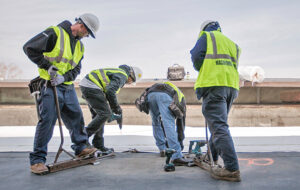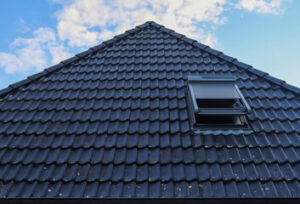Roofing Pikesville MD is the construction and maintenance of the top layer of a building or structure. It protects against rain, snow, sunlight, and extreme temperatures.

A roof’s shingles can be made of a variety of materials. They can also have different colors, shapes, and designs. A shingle’s quality is measured by its ability to withstand impact.
There are many different roofing materials to choose from, and each one offers unique advantages. The type of roofing material you choose will depend on your budget, style preferences and the climate in your region. A professional roofer can help you select the best roofing material for your home.
The most popular roofing materials are asphalt shingles and metal. Both are durable and offer a range of color options and styles to suit any architectural style. Metal roofing is available in several types, including galvalume, aluminum, copper and zinc. It is also energy-efficient and can last for decades. It is an excellent choice for homes in warm climates, as it reflects rather than absorbs heat.
Clay tile is another beautiful and long-lasting roofing material. It can be left unglazed, or factory-fired for a light or dark glaze and comes in a variety of colors and designs to match any architectural style. It is fire-resistant, water-proof and can withstand a lot of heat. It is a good option for hot or coastal regions and can add a touch of elegance to any home.
Wood shingles or shakes are another popular roofing material. They are often seen on Cape Cod and Craftsman-style homes. They are a great choice for a rustic or natural look and can be stained to match any color scheme. Shingles are sawmilled for uniformity, while shakes are split into wedge-shaped slabs that produce a more rugged texture. Wood is not as resilient as some other roofing materials and is prone to damage from insects and moisture.
Concrete tiles are another durable roofing material, and they can be made to mimic the appearance of shingle or shake roofing. They are a good choice for a modern or contemporary house, and they are also a great option for homes in colder climates as they reflect rather than absorb heat. Concrete tiles are heavy, however, and require a substantial support structure. They are also a poor choice for areas with high rainfall or humidity.
Roofing Installation
The roof is the protective covering of a building or structure that serves to guard against rain, snow, sunlight, wind, and extremes of temperature. Roofing involves the construction and installation of a variety of different roof types, from pitched or sloping roofs to flat roofs with little to no slope. The roofing materials and installation process vary for each type.
A well-constructed and maintained roof provides both a comfortable environment and increases the value of your home. It is important to find a roofing contractor that is licensed and insured with a proven track record. Before hiring a roofing company, ask to see examples of their work. Review online reviews and testimonials and request references.
Proper roof ventilation removes moisture from the attic and regulates temperature in the home, decreasing energy costs. Adding ridge vents, gable vents, or soffit vents will allow air to pass through the underlayment and prevent damage to the roof deck and insulation. Waterproofing the valleys is also critical; this is done by running underlayment over the ridge and nailing it in a pattern that overlaps each row of underlayment by at least six inches, with nails spaced closer together near the edge of the roof.
Roofing Repair
If your roof has moderate damage, it may make sense to repair instead of replace. It will usually be cheaper, too. But before you can start repairing, you need to assess the problem. This requires examining the roof and understanding how it is designed to function.
If you see signs of leaks, such as dark streaks on the ceiling or deteriorating insulation, locate where these issues are occurring and follow the trail back to find the source. You might find a hole in the roof deck, damaged or missing shingles, or a leaky flashing section.
Fixing flashing is typically a simple matter of removing the old piece, cutting and bending a new one, and re-sealing it. When nailing flashing, try to mimic how the previous piece was fixed to the roof, whether it was nailed or sealed, and use the same technique. If you’re unsure, ask for advice from a roofing professional. Likewise, when using sealant, be sure to apply it where needed and not to areas that could come into contact with water.
Roofing Maintenance
Regular roofing maintenance should include inspections by trained roof professionals on a biannual basis to detect problems before they deteriorate. In addition, roof inspections should be made after severe weather events such as hailstorms and natural disasters, as damage from these events can quickly escalation. During inspections, roof flashings should be inspected for moisture accumulation and other conditions that lead to leaks, especially around skylights, perimeters, walls, penetrations, equipment curbs, drains, and more. Stairs, crossovers, platforms, and railings should also be inspected for deterioration and structural integrity, as these elements can pose safety hazards to repairmen on the rooftop. In addition, tree limbs that hang over the roof should be trimmed to prevent them from falling during heavy storms and damaging roofing surfaces and elements.

